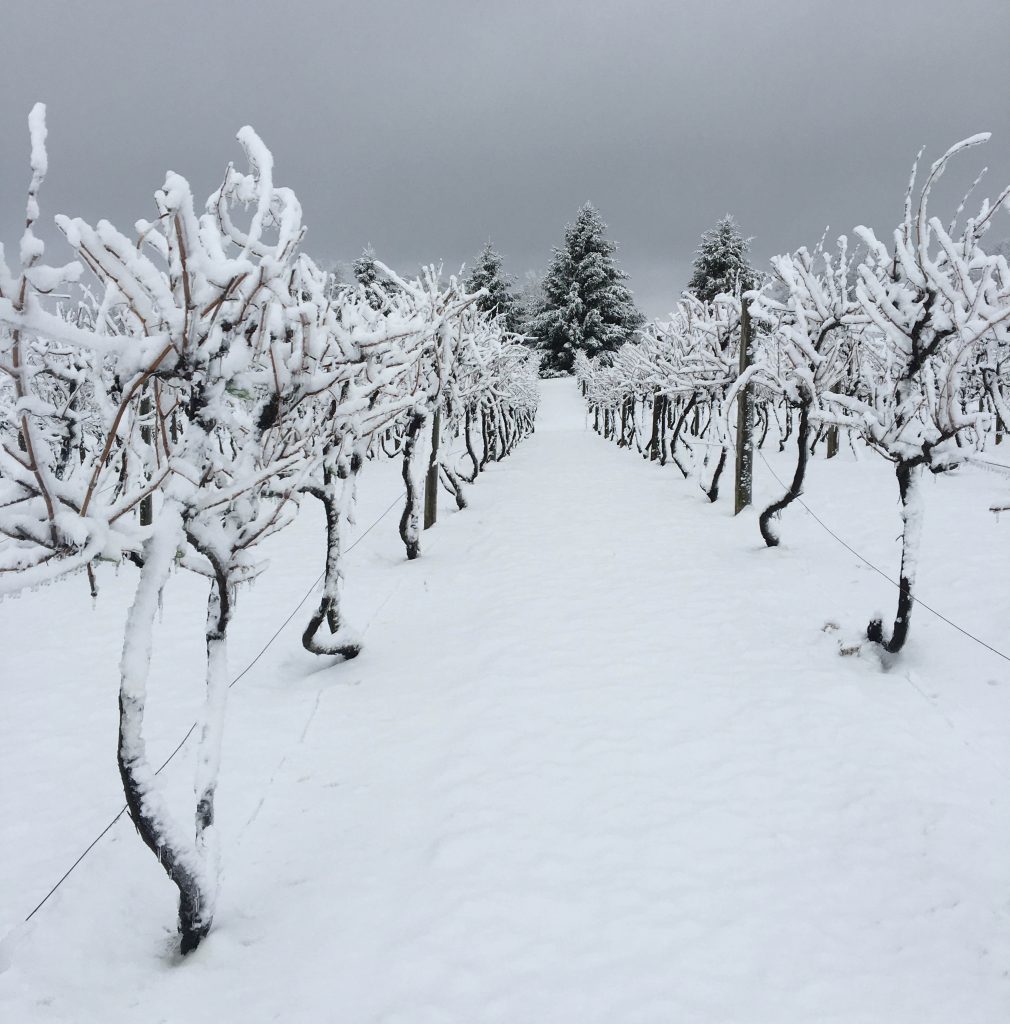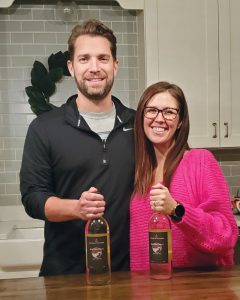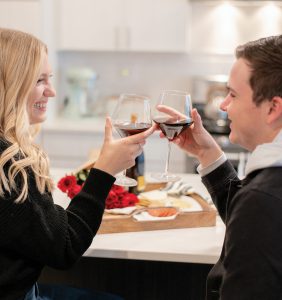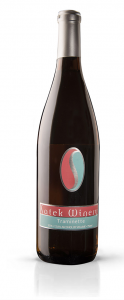
Kay and Ron Kummer.
Valentine’s Day has always meant wining and dining, dancing and romancing. But this year, the continuing cloud of COVID-19 has kept Cupid on the q.t.
Leave it to Indiana’s enterprising wineries and vineyards to keep the crafted potables Hoosiers have come to love accessible and a part of this Feb. 14 or any special occasion, despite the pandemic.
“In the past, we have always looked to Valentine’s Day as one of the first ‘holidays’ where people unearth themselves from their house after a long winter and are anxious to get out,” said Shane Christ, the winemaker at Satek Winery in Steuben County.
Though COVID has continued the public hibernation into 2021, he noted, “There’s a lot of things we can do that do not require social gathering.”
“Folks are finding ways to travel and get out, and wineries seem to be a great outlet,” said Jill Blume, enology specialist with the Purdue Wine Grape Team which supports the wineries.
“Some of these wineries are remote and a little hard to find,” she added. “So, it’s a little adventure in that sense. It’s a fun country drive, and I think a lot of people are ready to get some air.”
Flourish
Rural Indiana has seen an extraordinary growth in the state’s wine industry in the past 30 years. This form of agritourism gets folks out into the Indiana countryside to enjoy the fruits of the vines and the handcrafted labors of love.
There are now over 120 wineries and vineyards dotting the state. Thirty years ago, there were nine. Those wineries provide almost 4,000 full-time jobs. Indiana’s wine production in 2018 exceeded 2.4 million gallons (12 million bottles) and was ranked 11th nationwide.
Eight wine trails, mapped out from Indiana’s southern shores of Lake Michigan to the northern banks of the Ohio River and almost everywhere in between, provide Indiana’s 630,000 annual “wine tourists” conveniently charted routes. Indiana’s wineries serve up vast varieties of fermentations from whites to reds, sweets to dries, and traditional grapes to any number of fruits and combinations.
While for the past year social media has been filled with running jokes alluding to wine’s ability to see many of us through such things as quarantines, social distancing, school closures and e-learning (that has kept the kids at home and some parents traumatized), the real spirit of Indiana’s wineries isn’t what’s consumed. Rather, Indiana’s wineries and vineyards are really about celebrating friendship, family and life’s good times together — very often in the beautiful rural settings.
“We are really proud of that agritourism element of what a farm winery is,” said Rachel Gibson, executive director of the Indiana Winery and Vineyard Association. “When you visit a winery, in most cases, you’re looking at the vineyard; you’re seeing where the grapes are grown.”
The pandemic -— as it has on most all small businesses, especially in the entertainment, food and tourism industries — has left many wineries struggling. Wine bars and tasting rooms had to close or reduced capacity, and many special popular annual events were canceled.
“During the summer, the wineries were a lot better able to pivot and seat people and keep everyone socially distanced from each other. The traditional model where you walk in, stand at the bar and taste two or three samples and then make a purchase is no longer a viable model while we’re fighting COVID,” Gibson said. “In a lot of cases, people have had to rethink their tasting rooms altogether to figure out seating areas and so on.”
Wineries have had to be creative maintaining and growing their customer base during COVID, she said. “As an industry, we’ve actually done pretty well. These are entrepreneurs. They’ve all figured out a different niche and a different business model and a different product they’re offering.”
Wineries started offering curbside sales and free delivery of online orders. Some offer virtual wine tasting in which a customer buys a “wine-sampling kit” at the winery, then goes home and logs into Zoom for the virtual tasting experience with the winery’s experts.
Wineries that have developed relationships with wholesalers and are able to sell their products beyond their tasting rooms have certainly been more insulated during the pandemic, noted Christ, who is the president of the winery and vineyard association. “If you look at the sales of your liquor stores and grocery stores … that’s what’s really been the lifeline to a lot of wineries.
For special events, like Valentine’s Day, wineries are preparing special boxes of selected wines. Some traditional events, like pairings of wines and chocolates, were still scheduled at many of the state’s wineries. But, as with most things during this time, interested readers are always encouraged to visit the local wineries’ websites for latest details.
Satek, which celebrates 20 years in business in 2021, will continue one item that’s related to Valentine’s Day that Christ says has developed a “cult following” in recent years. That’s its chocolate sauce. The sauce, which is about 5% alcohol, is specially made for Satek by a chocolatier in California’s Napa Valley using Satek wines. “It’s a nice little gift item,” Christ said.
Fruition

Down state from Satek, about as far down state as you can go without driving into the Ohio River at the bottom of the state, is Bottom of the Barrel Winery in downtown Tell City.
The winery isn’t celebrating 20 years in 2021, like Satek, nor even 20 months. It opened its doors Dec. 15, 2020, and is celebrating two months in business this Valentine’s Day. Owner and one of its winemakers Adam Brockman, a chiropractor by day at his next door Complete Wellness Center, has turned his hobby into a business.
Opening a new establishment during a socio-economic hardship might not be ideal, but for Brockman, it’s become an unlikely business plan. The 39-year-old Perry County native opened his first clinic across the river in Hawesville, Kentucky, in 2008 — during the great recession. “It’s something we’ve been through before, and we’ve been able to build our clinic system.” (Brockman, who is also a doctor of naturopathic medicine, has clinics in Evansville; Hartford, Kentucky; and Santa Rosa Beach, Florida, as well.)
The winery on Main Street opened with limited hours before Christmas to allow holiday shopping. It then hosted a special New Year’s Eve gathering for a limited number of couples that included a bottle of wine and a meat and cheese board. He said a similar limited gathering for couples is in the works for Valentine’s Day that would include wine and chocolates.
Bottom of the Barrel’s roots sprung from the building itself — which once housed a dry cleaning business — that Brockman bought about a year and a half ago. “The building needed a lot of repairs done,” he said, “so I had been asked if they could drop a dumpster in my clinic parking lot.” He ended up buying the building.
He and fiancée Megan Harth, a nurse practitioner at his clinic, then asked themselves what would they want to see in town. “It was just like a lightbulb clicked when we came up with the idea.”
Two other wineries were already in Perry County. One, Winzerwald Winery, was 25 miles up the road along I-64; the other, Blue Heron, sits in the hills directly above the Ohio River at Rocky Point. Brockman said Bottom of the Barrel will join Blue Heron on the Hoosier Wine Trail that connects wineries along the river.
“Our winery and theirs will really be able to play off of each other. You can come to Perry County, and you can see the beauty where Blue Heron is, and you can come here and have a little bit of a different atmosphere — like a big city vibe in a small town.”
The name they chose for their winery, Brockman said, sums up their attitude: “Have fun; don’t take yourself, or the wine, too seriously; and make it through anything thrown your way.”
Brockman and another winemaking hobbyist crafted Bottom of the Barrel’s wines with professional vintner Gary Humphrey, who owned and operated River City Winery for over 10 years upriver in New Albany. Humphrey is on the board of the Indiana Wine Grape Council and produced the “Wine of the Year” at the 2012 Indy International Wine Competition.
Brockman noted he intends to eventually create a vineyard on land he owns on the outskirts of Tell City. But for now, the grapes and apples used to make their wines came from Indiana and Michigan. “The tanks came from Italy,” he added. “We were fortunate that we ordered them before COVID hit, otherwise we probably still wouldn’t have them.”
Keeping in line with thoughts of Valentine’s Day and romance, one interesting thing about putting the winery in a building once occupied by a dry cleaner, Brockman noted, was the artifacts left behind. The cleaning chemicals, of course, and most of the old equipment were long gone. But before gutting the entire building down to its brick walls, they found clothing, still in the plastic garment bags, that customers never claimed — including wedding dresses. “That would be good for bachelorette parties,” he quipped. “You can also come pick out your dress.”
He said originally, they hoped to have the winery open for the city’s annual Schweizer Fest in August. But when the festival was greatly pared down because of COVID, they decided to take a little more time with the wines and preparation. He did want to make sure they opened before the end of the year. “I just thought it was important to give people something that we can look forward to; 2020 wasn’t a great year, but 2021 is something we can look forward to.”
Forward

Shane Christ at Satek noted another thing wine lovers can especially look forward to this entire coming year is the 2020 vintage. The year itself might be best forgotten, but Christ advises not to judge the wine under the 2020 label by the memories.
“One bright spot of 2020 was our growing year. Our summer was really hot; it was really dry; and it was really long; and that proved to be one of the better growing years for producing fruit,” he said.
“Though the yields were about the same as a typical year, the concentration of the flavors in the grapes was much higher, and the fruit chemistry was ideal,” he explained. “I am expecting some outstanding wines throughout the state.”
With the new vintage and the hope COVID subsides soon, Christ predicts, “It’s going to be a great summer to get out of the house. It’s going to be a great summer to go visit. It’s going to be a great summer to catch back up with your friends and go out to dinner.”
And along with catching up and dining, there’s sure to be some wining, and maybe a little dancing and romancing.
For more information on Indiana’s wineries and trails, visit:
https://satekwinery.com
https://www.facebook.com/bottomofthebarrelwine
https://indianawines.org/hoosier-wineries/
RICHARD G. BIEVER is senior editor of Indiana Connection.
Indiana wine industry economic impact

- $95 million Indiana wine sold
- $94 million tourism expenditures
- $603 million total economic impact
- 2.4 million gallons produced
- 600 grape-bearing acres
- $590,000 vineyard revenue
- $120 million paid wages
- 3,900 full-time jobs



